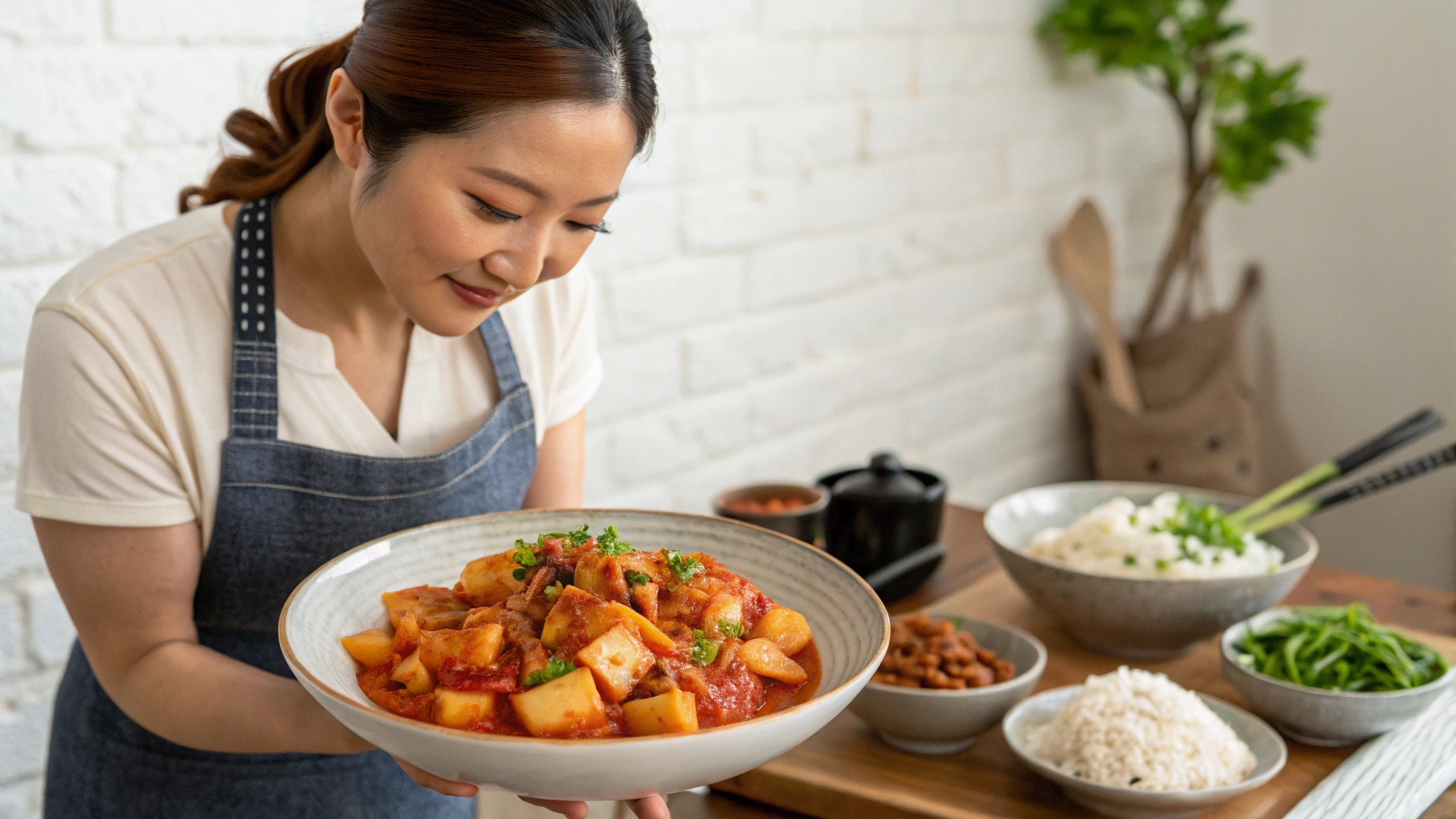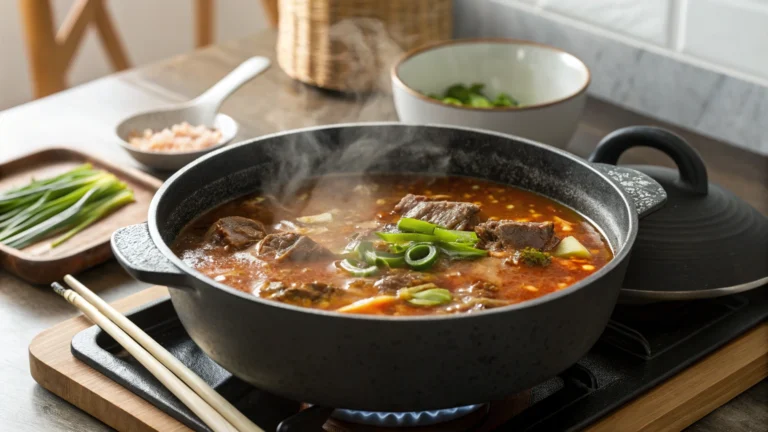7 Bold Reasons to Try Apple Kimchi for a Sweet and Spicy Twist
Craving kimchi? Try apple kimchi for a refreshing twist! It’s a sweet, spicy, and crunchy Korean side dish that’s quick, easy, and bursting with flavor.
Table of Contents
I. Introduction: Beyond the Cabbage – The Allure of Apple Kimchi
Traditional kimchi, usually made with cabbage, is a staple in Korean cuisine. However, there’s a world beyond baechu kimchi, and it includes delicious variations like apple kimchi (also known as apple saengchae). This vibrant and flavorful dish offers a unique sweet and spicy profile that’s both refreshing and exciting. Apple Kimchi, unlike its fermented cousins, is often enjoyed fresh, offering a lighter, crisper experience.
Apple kimchi is a delightful change from the usual fermented cabbage. The crispness of the apples combined with the fiery gochugaru creates an addictive combination. Therefore, consider this recipe as a simple way to impress your family and friends!
Therefore, in this article, we’ll explore 7 bold reasons to try apple kimchi for a sweet and spicy twist. This unique flavor profile is something you won’t want to miss. Plus, apple kimchi can easily be made vegetarian or vegan friendly.
II. What is Apple Kimchi? A Deep Dive into Its Origins & Preparation
Kimchi has a long and rich history in Korea, dating back centuries. The fermentation process was initially used as a method of preserving vegetables through the harsh winters. Over time, various regional variations emerged, utilizing different vegetables and spice combinations. While cabbage kimchi (baechu kimchi) remains the most well-known, other versions like radish kimchi (kkakdugi) and cucumber kimchi (oi sobaegi) are also incredibly popular.
The Key Ingredient: Why Apples are Good for Kimchi?
The use of apples in apple kimchi is not just a modern innovation. Apples provide a natural sweetness that balances the spiciness of the gochugaru. In addition, their crisp texture contrasts nicely with the other vegetables, creating a delightful sensory experience.
However, the most important part is to choose the right apple to have a kimchi that is even more tasty and delicious.
Traditional vs. Modern Interpretations of Apple Kimchi
Therefore, apple kimchi fits comfortably within the broader kimchi landscape. It’s a fresher, quicker alternative to fermented kimchi, appealing to those who prefer a milder flavor or are short on time. Besides apples, modern interpretations may also incorporate other fruits like pears or Asian pears.
Regional Differences
While apple kimchi is not strongly associated with any specific region, variations can be found depending on local produce and preferences. For example, some regions might use locally grown apples or add specific types of seafood.
A Healthier and Fresher Alternative
One advantage of apple kimchi is that it offers a slightly different nutritional profile compared to fermented kimchi. It’s packed with vitamins, minerals, and fiber from the fresh vegetables and apples. In addition, the apple kimchi contains prebiotics that are very good for gut health.
III. 7 Bold Reasons to Try Apple Kimchi for a Sweet and Spicy Twist!
A Fresh Twist: 7 Reasons to Try Apple Kimchi for a Sweet and Spicy Kick!
- A. Reason 1: A Symphony of Flavors: Sweet, Spicy, and Savory in Every Bite
The real magic of apple kimchi lies in its complex flavor profile. The sweetness of the apples initially greets your palate. Subsequently, the heat from the gochugaru kicks in, creating a delightful contrast. Furthermore, if fish sauce or shrimp paste is used (or a vegan substitute), it adds a savory umami depth that balances the sweetness and spice. Therefore, it’s a truly harmonious blend of flavors that tantalizes the taste buds.
- B. Reason 2: Texture That Pops: A Crunchy Delight
Apple kimchi offers a satisfying textural experience. The apples retain their crispness, providing a delightful crunch with every bite. In contrast, other vegetables, such as daikon radish and carrots, offer varying degrees of chewiness. Therefore, this combination of textures makes apple kimchi a much more engaging dish than a traditional, softer cabbage kimchi.
- C. Reason 3: Quick & Easy to Make: Perfect for Weeknight Meals
Unlike traditional kimchi, which requires fermentation, apple kimchi is quick and easy to prepare. The apple kimchi can be eaten right away, or stored to eat later. Therefore, this makes it a perfect option for busy weeknight meals. The entire process, from prepping the ingredients to combining them, takes only about 20-30 minutes. A kimchi recipe for beginners.
- D. Reason 4: A Versatile Culinary Companion: Endless Serving Options
Apple kimchi is incredibly versatile and can be used in countless ways. For example, it makes a delicious side dish alongside grilled meats or fish. In addition, it’s a fantastic topping for tacos, burgers, and sandwiches. Furthermore, you can mix it into rice bowls, noodle bowls, or green salads for an extra kick of flavor and texture. Thus, its adaptability makes it a valuable addition to any kitchen.
- E. Reason 5: A Nutritional Powerhouse: Vitamins, Fiber, and Antioxidants
Apples are packed with essential vitamins, fiber, and antioxidants, which are beneficial for your overall health. In addition, gochugaru contains capsaicin, which has anti-inflammatory properties. Furthermore, garlic and ginger are known for their immune-boosting benefits. Therefore, apple kimchi offers a combination of nutrients from all of its ingredients.
- F. Reason 6: Impress Your Guests: A Unique & Unexpected Dish
Bring something different to the table! Apple kimchi is a unique and unexpected dish that is sure to impress your guests. Besides, its vibrant colors and complex flavors make it a conversation starter. Moreover, it elevates any meal, making it feel special and memorable.
- G. Reason 7: Customizable to Your Taste: Make it Your Own!
The best part about apple kimchi is that it’s easily customizable. Therefore, you can use different types of apples, adjust the level of spiciness, or add other fruits and vegetables to suit your preferences. For example, you might add some pears, Korean pears, or use more or less gochugaru. Therefore, you can experiment and create your own signature version of apple kimchi.
IV. Key Ingredients: Sourcing and Understanding Their Roles
- A. Apples: Choosing the Right Variety
Therefore, the best apples for apple kimchi are those that are crisp and slightly tart. Fuji, Honeycrisp, Gala, and Pink Lady apples are all excellent choices. For example, Fuji apples offer a balanced sweetness, while Honeycrisp apples provide a satisfying crunch. The right apple will enhance the overall flavor and texture of the kimchi.
- B. Gochugaru: Finding the Perfect Spice Level
Gochugaru is Korean chili powder, and it’s essential for achieving the signature spiciness of kimchi. It has a vibrant red color and a slightly smoky flavor. Therefore, to find the perfect spice level, start with a smaller amount and add more to taste. If you can’t find gochugaru, you can substitute with other chili flakes, but be mindful of the heat level.
- C. Fish Sauce/Shrimp Paste: Umami Boost (and Vegetarian Alternatives)
Fish sauce or shrimp paste adds a crucial umami element to apple kimchi. However, for vegetarian or vegan versions, you can substitute with soy sauce, tamari, mushroom broth, or kelp granules. These alternatives will provide a similar savory depth of flavor.
- D. Other Vegetables: Daikon Radish, Carrots, Green Onions, and More
Daikon radish and carrots add crunch and subtle sweetness to apple kimchi. Besides, green onions contribute a mild onion flavor. Therefore, these vegetables complement the apples and spices perfectly. If you can’t find daikon radish, you can use regular radish or even jicama.
- E. Garlic & Ginger: The Aromatic Duo
Garlic and ginger are essential for adding aromatic complexity to apple kimchi. Freshly minced garlic and ginger provide the best flavor. Therefore, you can use powdered garlic and ginger in a pinch, but the flavor won’t be as vibrant.
V. How to Make Apple Kimchi: A Step-by-Step Recipe
Ingredients:
- 2 medium apples (Fuji, Honeycrisp, or Gala), peeled, cored, and thinly sliced (about 300g or 10.5 ounces)
- 1/2 cup daikon radish, julienned (about 75g or 2.6 ounces)
- 1/2 cup carrots, julienned (about 75g or 2.6 ounces)
- 1/4 cup green onions, thinly sliced (about 25g or 0.9 ounces)
- 2 cloves garlic, minced (about 6g or 0.2 ounces)
- 1 teaspoon ginger, minced (about 3g or 0.1 ounces)
- 2 tablespoons gochugaru (Korean chili powder), adjust to taste (about 12g or 0.4 ounces)
- 2 tablespoons fish sauce (or soy sauce/tamari for vegetarian/vegan) (about 30ml or 1 fluid ounce)
- 1 tablespoon rice vinegar (about 15ml or 0.5 fluid ounce)
- 1 teaspoon sugar (about 4g or 0.14 ounces)
- 1 teaspoon sesame seeds (optional) (about 3g or 0.1 ounces)
Instructions:
- Prepare the Apples: Peel, core, and thinly slice the apples. Therefore, you can use a mandoline for even slices. Besides, place the sliced apples in a large bowl.
- Prepare the Other Vegetables: Julienne the daikon radish and carrots. Also, thinly slice the green onions. Therefore, add them to the bowl with the apples.
- Make the Kimchi Paste: In a small bowl, combine the minced garlic, minced ginger, gochugaru, fish sauce (or soy sauce/tamari), rice vinegar, and sugar. Therefore, mix well until a paste forms.
- Combine the Vegetables and Paste: Pour the kimchi paste over the apples and vegetables. Therefore, using your hands (wear gloves to prevent staining), gently mix everything together until the vegetables are evenly coated with the paste.
- Storage and Serving: Therefore, you can serve the apple kimchi immediately, or store it in an airtight container in the refrigerator. Besides, it will taste best after a few hours, allowing the flavors to meld together. Apple kimchi will last for about 3-5 days in the refrigerator.
Pro Tips for Success:
- Therefore, wear gloves to avoid staining your hands with the gochugaru.
- Also, mix the kimchi thoroughly to ensure the flavors are evenly distributed.
- Besides, adjust the spice level to your preference by adding more or less gochugaru.
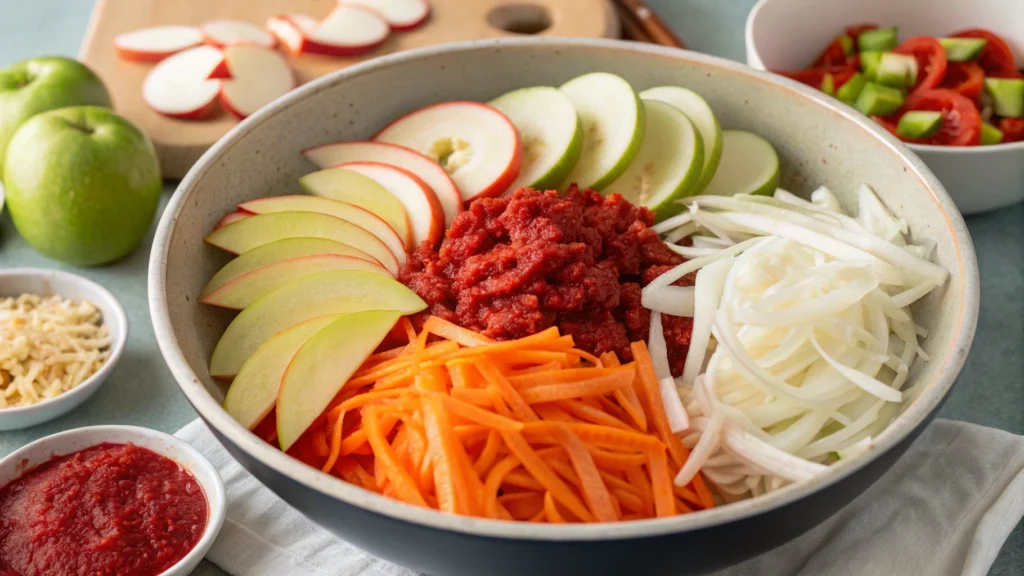
VI. Serving Suggestions: Beyond the Side Dish
- A. Apple Kimchi as a Topping: Therefore, try topping your tacos, burgers, sandwiches, or eggs with apple kimchi for a burst of flavor. For example, it pairs well with pulled chicken tacos or a breakfast sandwich.
- B. Apple Kimchi in Bowls and Salads: Also, add apple kimchi to rice bowls, noodle bowls, or green salads for a crunchy and spicy element. For example, it’s delicious in a Korean-inspired bibimbap bowl.
- C. Apple Kimchi with Meats: Therefore, serve apple kimchi alongside grilled pork, chicken, or beef. The sweetness of the apples cuts through the richness of the meat.
- D. Apple Kimchi in Fusion Cuisine: Also, experiment with incorporating apple kimchi into Western dishes. For example, try it as a topping for pizza or as a filling for omelets.
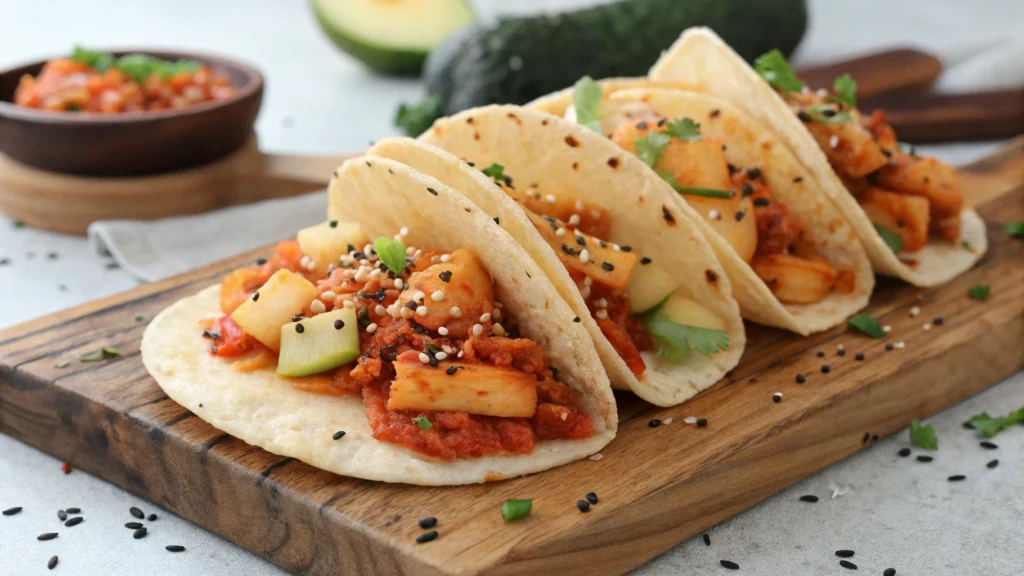
VII. Health Benefits: More Than Just a Delicious Treat
- A. Apples: Rich in Fiber, Vitamins, and Antioxidants: Apples are an excellent source of fiber, which aids in digestion. Also, apples provide essential vitamins and antioxidants, promoting overall health.
- B. Gochugaru: Capsaicin and its Potential Benefits: Gochugaru contains capsaicin, which may have anti-inflammatory and metabolism-boosting properties.
- C. Garlic and Ginger: Immune-Boosting and Anti-Inflammatory Properties: Garlic and ginger are known for their immune-boosting and anti-inflammatory benefits.
- D. Gut Health: Fermented foods have good bacteria, improving the gut health and increasing the body’s digestive system.
VIII. Troubleshooting & FAQs
People Also Ask about Kimchi Recipe:
- “My kimchi is too spicy/not spicy enough”: Therefore, adjust the amount of gochugaru in the recipe to control the spice level.
- “My kimchi is too sweet/not sweet enough”: Therefore, adjust the apple-to-vegetable ratio to achieve the desired sweetness.
- “How long does apple kimchi last?”: Apple kimchi will last for about 3-5 days in the refrigerator.
- “Can I freeze apple kimchi?”: Freezing apple kimchi is not recommended, as it can alter the texture of the apples.
- “Is this recipe gluten free?”: If you substitute fish sauce for soy sauce/tamari, the recipe is gluten free. Ensure that you are using tamari instead of soy sauce.
People Also Ask about Baechu Kimchi:
- “How long does baechu kimchi take to ferment?”: Baechu kimchi typically ferments for 3-5 days at room temperature, then is refrigerated to slow the fermentation process.
- “What are the main ingredients in baechu kimchi?”: The main ingredients in baechu kimchi are napa cabbage, gochugaru, garlic, ginger, fish sauce, and various vegetables.
- “How can I tell if my baechu kimchi has gone bad?”: If baechu kimchi develops a strong, unpleasant odor or shows signs of mold, it has likely gone bad.
People Also Ask about Recette Kimchi Korean:
- “What is the difference between kimchi and apple kimchi?”: The main difference is that kimchi is primarily made from cabbage, while apple kimchi has apples for a sweeter and crispier twist.
- “What are the key ingredients needed for the recipe for a Korean Kimchi?”: The key ingredients are gochugaru (Korean chili powder), garlic, ginger, and Korean pear.
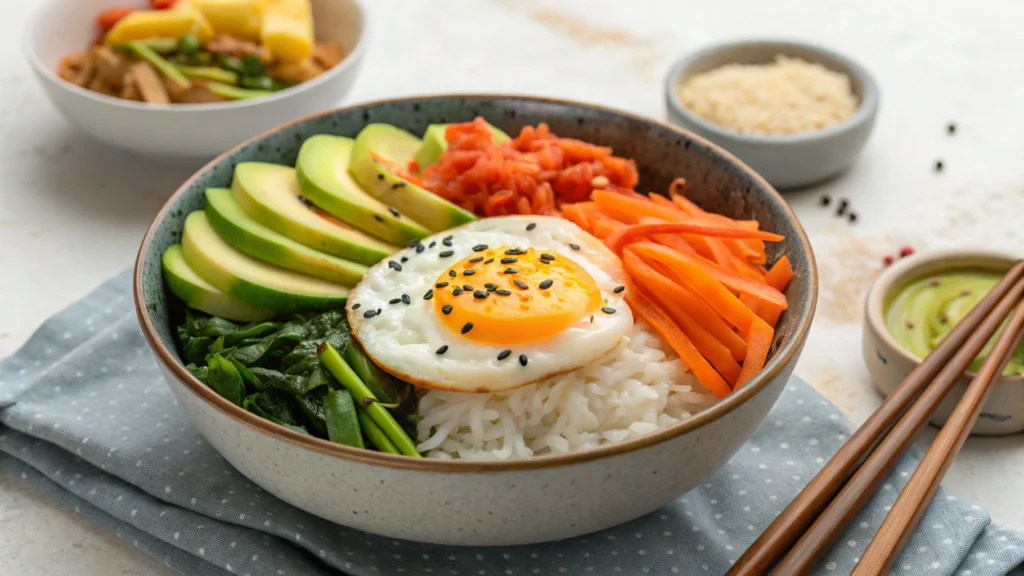
Nutritional Content (per 100g):
| Nutrient | Amount |
| Calories | 60 |
| Total Fat | 2g |
| Saturated Fat | 0g |
| Cholesterol | 0mg |
| Sodium | 300mg |
| Total Carbohydrate | 10g |
| Dietary Fiber | 2g |
| Sugar | 6g |
| Protein | 1g |
IX. Conclusion: Embrace the Apple Kimchi Adventure
Apple kimchi offers a delightful twist on traditional kimchi, combining the sweet and spicy flavors of apples and Korean spices. It’s quick, easy, versatile, and packed with nutrients. Therefore, we encourage you to try this recipe and experiment with your own variations to find your perfect apple kimchi. Share your creations with us in the comments or on social media!
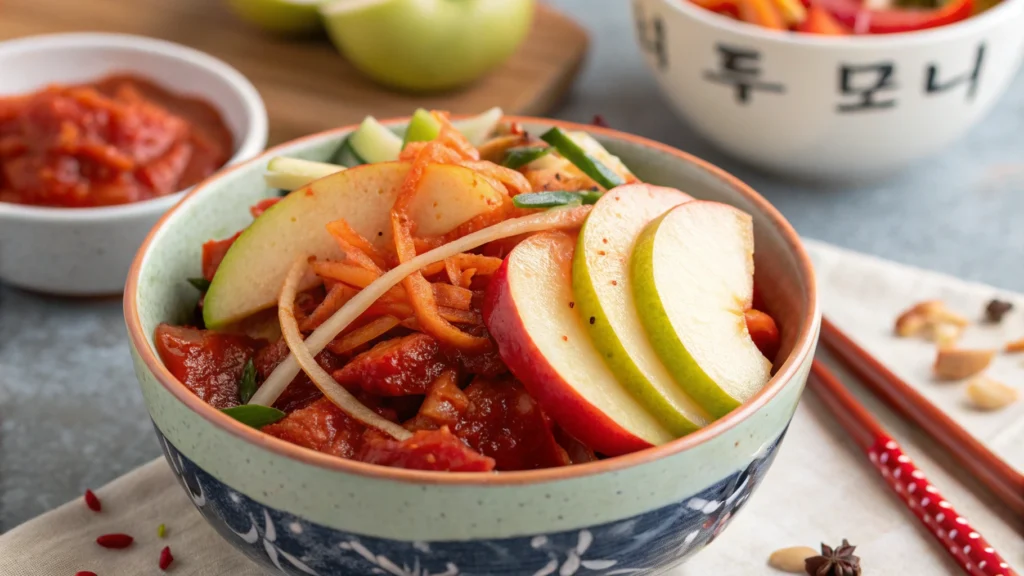
Cooking is an act of love and creativity! 🌟 What do you think of this recipe? I’d love to hear your thoughts and any tips or tweaks you’d suggest to make it even better. Let’s inspire each other in the kitchen!
There are no reviews yet. Be the first one to write one.


